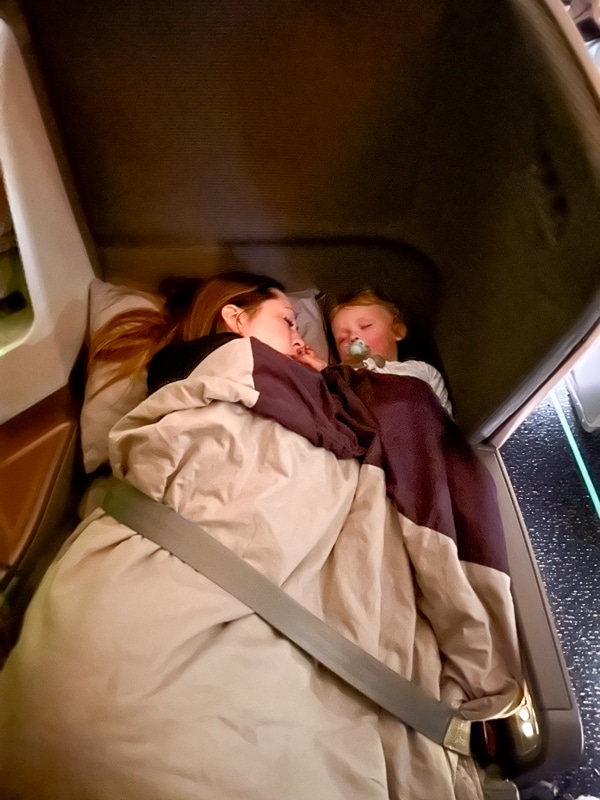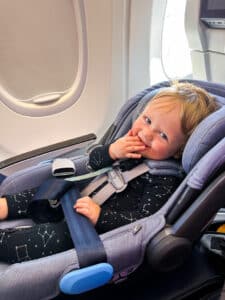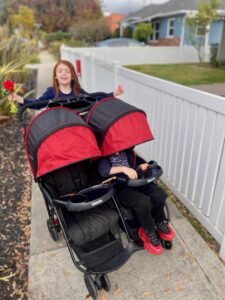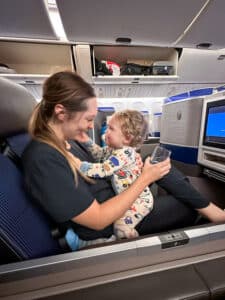Airplane Bassinets – Everything to Know and How to Reserve One
Flying with a baby can be both exciting and challenging. As a mother who has navigated the skies with my little one many, many times (over 100 while he is still a ‘lap infant’), I understand all too well the importance of finding ways to make the journey smoother.
One of the lifesavers in the world of flying with an infant is the airplane bassinet. In this blog post, I’ll share my experiences and insights on reserving an airplane bassinet, the ideal seats for it, the pros and cons, and the booking details, including weight limits, for major airlines like Delta, United, American, Japan Airlines, ANA, Singapore, Emirates, and Qatar:
Reserving the Bassinet
An airplane bassinet is a free perk that fastens to the wall in front of a coach seat or usually in an open space near the TV monitor on a business class seat. It’s provided by the airline and can only be used when at cruising altitude and when the seatbelt sign is off.
The airplane bassinet is a coveted amenity for parents traveling with infants, but sadly getting one usually isn’t as simple as selecting it during your online booking process. Most airlines allocate a limited number of bassinets per flight, so the key is to reserve one as early as possible and especially a seat that’s compatible with one – the highly sought after bulkhead.
When booking your ticket, be sure to call the airline’s customer service to request a bassinet. Some airlines allow you to do this over the phone, while others can’t confirm availability until you’re physically at the gate, unfortunately. Either way, don’t procrastinate as bassinets are typically assigned on a first-come, first-served basis.
Choosing the Right Seats for the Bassinet

If flying in coach, the only way to reserve a bassinet is to get in the bulkhead — or front — row. These seats provide the necessary space for the bassinet to be securely attached to the wall. Often this is a premium economy seat and since the bulkhead often has more legroom, people book these out early. If flying in business class, it’s the same deal, with the front-rows usually allowing for bassinet space. Depending on the airline, these seats are saved for parents, but most domestic airlines don’t offer this perk.
For this reason, we’ve flown with a bassinet far less often than I thought we would, and it’s often been luck of the draw that we’ve been able to get one at all. We often don’t know until we’re about to take off if the plane happens to have one.
Pros and Cons of the Airplane Bassinet

Although bassinets come with a lot of pros, the cons often outweighed them and as pictured above, I often chose to have my baby in my seat instead. Here’s why:
The Pros
- Hands-Free Time: One of the most significant advantages of the airplane bassinet is that it provides parents with some hands-free and lap-free time during the flight. This is invaluable for eating, resting, or entertaining a toddler on a flight, if you are flying with multiple young kids.
- Comfort for the Baby: The bassinet offers a cozy and secure space for your baby to sleep, especially during long-haul flights. This can contribute to a happier and more relaxed travel experience for your little one.
- Proximity to Parents: Being in close proximity to the bassinet allows you to attend to your baby’s needs promptly. It’s reassuring to know that you’re just a glance away, ensuring your peace of mind throughout the journey.
The Cons
- Limited Availability: As mentioned earlier, bassinets are limited, and not all flights or aircraft have them. This limitation can be a source of stress for parents who are unable to secure one, and I learned never to count on them.
- Weight and Age Restrictions: Most airlines have specific weight and age restrictions for the use of bassinets. If your baby exceeds these limits, or if they can sit up on their own, the bassinet becomes unusable.
- Restricted Movement: While the bassinet provides a comfortable sleeping space, it’s not suitable for extended periods of play. As your baby grows more active, the confined space may become less appealing.
- Limited times of use: If there’s turbulence, you’ll be required to wake your baby up and take them out of the bassinet. For this reason, we stopped using them pretty early on and I’d just take my son into the seat with me, pictured above.
- Bulkhead seats aren’t always ideal: Bulkhead seats are often by the toilets and/or galley, so they can be loud. They usually have fixed arm rests that can’t be moved as well, so if you’re traveling with another kid, you won’t be able to move the arm rests. You’re typically not allowed to store anything by your feet, either, so make sure you have diapers and baby food stashed in the seat pocket prior to take off or landing!
Keep in mind that car seats cannot be installed in bulkhead seats, so bassinets can only be used for lap infants and not when baby has their own seat. Having their own seat is ultimately better and safer anyway, and gives them a safe sleep space in the car seat.
Navigating Bassinet Policies: A Guide to Major Airlines
As far as I know, there aren’t airlines that charge for bassinets. That doesn’t mean that all airlines offer one, though.
Now, let’s delve into the specific details of reserving an airplane bassinet with some of the major airlines:
Aer Lingus Aer Lingus is all about those transatlantic bassinets, except on their Boeing 757 planes. Remember to pre-book these beauties, and it’s a bit of a race since they’re subject to availability.
In an effort to encourage buying a baby their own seat, Aer Lingus offers a discounted child’s fare, which does not include a bassinet.
Aeroflot Aeroflot offers bassinets for babies under one year old, weighing a max of 24 pounds. You’ll need to give them a heads-up 36 hours before liftoff to secure your spot.
Aeromexico has bassinets available upon request during check-in. But here’s the catch – you need to be in an AM Plus seat, and your bundle of joy should tip the scales at no more than 24 pounds.
Air Canada‘s bassinets are for the under-25-pound squad who can’t sit upright yet and are available on 767-300ER (763), 777-200LR (77L), 777-300ER (77W), 787-9 (789), 787-8 (788), and A330 (333) aircraft. You’ll have to request them at check-in.
Air France Air France spreads the bassinet love to economy, premium economy, and business class passengers on long-haul flights. Secure your spot ASAP, or at least 48 hours before you embark. These cozy cribs are reserved for the under-22-pound, under-27-inch crowd.
Air Mauritius has infant cots on every international flight. Just make sure to request in advance, and they’ll confirm it during check-in.
Air New Zealand Air New Zealand’s got the bassinet hookup on many flights. Book your spot online with Seat Select, and look out for that bassinet icon. Heads up, though – there might be an extra charge for these primo seats.
Alaska Airlines has no bassinets on their flights. But if there’s an empty seat on your journey, your lap-held infant might just snag that extra spot at no extra charge. Read my experience flying with a baby on Alaska Airlines here.
American Airlines has bassinets on their 777-200, 777-300, and 787 aircraft for babies under 2, weighing less than 20 pounds. But here’s the kicker – it’s first-come, first-served, no advance requests allowed. American doesn’t make it the easiest for parents – read my American review for more info.
ANA (All Nippon Airways) If you’re flying ANA internationally in economy or business class with a lap infant, call ahead to secure one of these cozy spots. And hey, they even throw in a special baby blanket.
Asiana Airlines recommends reserving a bassinet early, especially since size limitations vary depending on the cabin and aircraft. Watch out for those height and weight restrictions!
Avianca Airlines has bassinets on routes operated by A330 and B787. Infants 12 months and under, weighing less than 25 pounds and measuring under 29 inches, can enjoy a snug spot.
British Airways offers bassinets only on long-haul flights for babies 2 and under and are booked during the ticket booking process. Seats with bassinet capability will have a baby icon.
Cathay Pacific Cathay Pacific’s got your back with bassinets on all their flights. Just request one when you’re booking, and your infant under 6 months, weighing up to 26.5 pounds, can snooze away.
China Airlines offers bassinets. Secure yours by booking an infant ticket early, and make sure your little one is under 6 months, no taller than 28 inches, and not more than 24 pounds.
China Southern Airlines China Southern Airlines has an Infant Bassinet Service (BSCT) for flights over 3 hours. Babies under 1, weighing less than 25 pounds and under 27.5 inches, can grab one of these limited spots and must be reserved in advance.
Condor only offers bassinets in business class on long-haul flights. But be on your game – reserve it no less than 48 hours before takeoff by calling Special Reservations.
Delta Air Lines Delta’s got you covered with SkyCots on select international flights. Babies weighing up to 20 pounds can cozy up in these free-of-charge spots. But beware, it’s first-come, first-served, and they can’t guarantee availability. Read my Delta with a baby review for all the info.
EasyJet Airlines EasyJet is all about being kid-friendly, but alas, no bassinets in sight. However, their website promises a smooth ride for infants and young children.
Emirates Emirates is a bassinet haven for kids up to 2 years old without their own seat. Request one at booking or later through Manage a Booking. These spacious spots can cradle babies up to 24 pounds and are held for parents up to 48 hours before takeoff. I love flying with Emirates with a baby – they’re the most family friendly airline I’ve experienced.
Etihad Airways Etihad Airways’ bassinets are first-come, first-served. Request during booking or through Manage My Booking. They’re designed for babies up to 24 pounds, ensuring a comfy flight.
EVA Air EVA Air’s got bassinets on all their flights, but size and weight limits apply. Remember to share your baby’s deets during reservation – it’s for safety reasons!
Frontier Airlines Frontier Airlines is skipping the bassinet party for now.
Garuda Indonesia Garuda Indonesia is offering baby bassinets on a first-come, first-served basis. when you request them well in advance but know they’ll only be confirmed at check-in.
JetBlue Airways does not offer bassinets.
Hawaiian Airlines is rocking bassinets on select A330 routes, available with advance reservations. Book those Extra Comfort seats (row 14), reserve your bassinet over the phone, and your infant, up to 20 pounds, will be lounging in style.
Iberia Iberia’s got cots for infants on long-haul flights, provided you’re in the right class and seat for infants weighing up to 24 pounds. Call ahead to reserve one.
Icelandair does not offer bassinets.
JAL (Japan Airlines) JAL is in the bassinet game, but reservations aren’t always a sure bet. When we flew them to Japan with our six month old, I tried to reserve ahead of time and was told I had to ask at the gate. However there weren’t any bulkhead seats left when I booked, which meant no bassinets. Still, it was a great experience flying Japan Airlines with our baby.
KLM Royal Dutch Airlines KLM’s got carycots on intercontinental flights, but reservations aren’t a guarantee. Request one through the website or the Customer Care Center. These cots are for babies no taller than 25.5 inches and no heavier than 22 pounds.
Korean Air offers reserved bassinets on international flights in economy and Prestige class. Give them a shout at least 48 hours in advance to secure one. These comfy spots are for infants under 24 pounds and shorter than 29.5 inches.
LATAM Airlines has bassinets on all routes operated by a 767, 777, or 787. Request yours in advance, but keep in mind it’s subject to availability for Babies weighing up to 22 pounds and measuring up to 28 inches.
Lufthansa Lufthansa’s got bassinets across its long-haul fleet, but book early – up to 52 hours before takeoff. Depending on your booking class, there might be a seat reservation fee. The bassinets are for babies under 24 pounds and under 26 inches.
Malaysia Airlines Malaysia Airlines is spreading the bassinet love on select aircraft, and it’s free of charge. Make the request 24 hours before departure through their Global Customer Contact Centre.
Qantas Airways has bassinets available to request at booking for babies up to 24 pounds.
Qatar Airways has bassinets for infants up to 24 months and 25 pounds. Give them a ring to check availability ahead of time. We found Qatar to be quite family friendly, especially if you can snag adjoining Q suites which turn into one large bed!
Ryanair does not offer bassinets – are we surprised?
Singapore Airlines Singapore Airlines offers bassinets for babies up to 30 lbs and such seats are reserved especially for parents, only opening up to everyone else for booking 48 hours before take off. As a parent with a lap infant, you may even be put in one of the bassinet seats whether you book it or not, as we found on a recent flight. Singapore is great to fly with babies and is unique with their larger capacity and ease of booking bassinet seats!
South African Airways South African Airways has bassinets for its tiniest travelers, reserved for bulkhead seat passengers. Ring them up to secure your spot for infants not exceeding 22 pounds and 29.5 inches.
Southwest Airlines is all about families but not so much about bassinets – you won’t find any onboard.
SriLankan Airlines SriLankan Airlines has bassinets available on long-haul flights for infants up to 6 months old and weighing no more than 24 pounds. Request these cozy spots during your booking or through their reservations department.
Sun Country Airlines does not offer bassinets.
SWISS International Air Lines offers bassinets on long haul flights. Make sure to reserve one at least 24 hours before departure for infants up to 15 months old and weighing up to 28 pounds.
TAP Air Portugal TAP Air Portugal is bringing bassinets to the party, free of charge. These cozy spots are for infants up to 2 years old, weighing up to 26.5 pounds. Book them in advance through their Contact Center or when purchasing your ticket.
Thai Airways has bassinets for infants under 2 years old on all flights. These spots can support a maximum weight of 26.5 pounds, and are bookable during the ticket booking process, but aren’t guaranteed until check-in.
Turkish Airlines Turkish Airlines is on the bassinet train, providing them on long-haul international flights. Request one during booking for babies up to 2 years old, weighing up to 28.7 pounds.
United Airlines has bassinets available on international flights, and we’ve also had success requesting one on a cross-country flight on an international-sized plane. These cozy spots are for infants up to 2 years old and weighing up to 25 pounds. I’ve only had luck requesting them at the gate, and as United’s bulkhead seats are not saved for parents, they’re hard to get. Read my full United with a baby review.
Virgin Atlantic has bassinets available during booking for infants under 2 years old, weighing up to 26 pounds.
Volaris, WestJet, and Wizz Air do not offer bassinets onboard.
Why We Rarely Utilized Airplane Bassinets
Even though I was initially thrilled about the idea of reserving a bassinet for my baby, and certainly would have done it more often if it were easier, most of the time, booking a bulkhead seat is pretty difficult. Everyone really likes to have these seats because of the extra legroom, and unless the airline specifically saves them for parents, like Singapore and Emirates, they book up early. In the case of United, it’s almost always in premium economy, so you will have to pay up for the privilege as well.
Additionally, having to wake my son up every time the fasten seatbelt came on actually made it harder to use the bassinet the few times we had one. For the most part, it was better for me to have him in a baby carrier on my body when he was younger or to use our miles to book business class for longer flights and share the seat with him.
He also aged out of bassinets pretty early on because he was always in the hundredth percentile for height and weight. However, smaller babies would have a much longer potentially use for them.
We also started buying my son his own seat on flights after his first year, both for safety and for our sanity. This gave us extra room, gave him a designated safe sleeping space in an FAA-approved car seat, and made it less of a big deal whether we got a bassinet or not.
If you really want to use a bassinet on a long haul flight, it’s worth considering flying with parent-friendly airlines like Singapore or Emirates that save those seats for parents. It’s one of the only ways to ensure you get the bassinet for sure!







